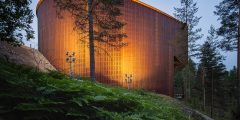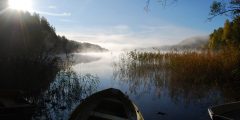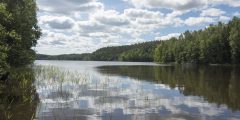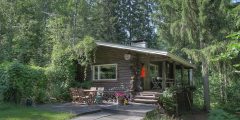01 Arrival
One ticket to think about at the airport - it will take you to and from the city centre, and give you free travel in the whole metropolitan area - is the Helsinki Card.
It is valid for 24, 48 or 72 hours (€46, €56 and €66, respectively – save €3 if you buy online) from the moment you validate it. Children (7 – 16) are half price. It costs only €4 more than the standard Helsinki Card, which also gives free use of public transport within the city, but not those wider travel options.
Both cards give free travel on public transport and on boat sightseeing tours. Included are the SkyWheel, Sea Life Helsinki, the Zoo, and the 15-minute ferry ride to Suomenlinna Sea Fortress, a tremendous bastion built on a cluster of rocky islands in 1748. You also qualify for discounts in restaurants, shops and saunas.
Alternatively buy the day ticket, from machines at stations and stops. It is valid for bus, tram or train for 9,00€. Two days is13,50€; 3 days is 18,00€.
02 What to see and do
Walkable City Centre
The city centre is compact enough to explore on foot. Among its easy easy, relaxing places are Esplanade Park. “Espa”, the green heart of Helsinki, is the most famous park in Finland. The Espa Stage hosts an epic festival of open air music, from May until the end of August.
The Neoclassical ensemble around Senate Square is the work of architect C.L. Engel, in the early 19th century. It includes the shining, white Helsinki Cathedral, the Palace of the Council of State, the main building of the University of Helsinki and the National Library of Finland.
The 19th-century Old Market Hall reopened after renovation in 2014 on the refreshed waterfront. The blue building on Market Square is the City Hall; the pale yellow one is the Presidential Palace. The striking Orthodox Uspensky Cathedral, with its golden onion-shaped domes, is the biggest Russian Orthodox Church in Western Europe.
One of the newer galleries (2015) is the Helsinki Art Museum (HAM) at Tennis Palace, Tennispalatsi. This functionalist building was put up in 1938 for the 1940 Summer Olympics (delayed by the war until 1952). The building, expanded and renovated, holds modern and contemporary art exhibitions.
HAM cares for an art collection that belongs to the people of Helsinki. Roughly half the 9,000 works of art in its collection are on display in parks, streets, offices, health centres, schools and libraries around the city, brightening up people’s lives.
Tram Tour
For a wider view of the city, the tram is the perfect conveyance. Three of the central tram routes give a useful overview of specific districts (free with the Helsinki Card and the day ticket). Tram 2 is regarded as the sightseeing tram. Its route passes the main sights, dominated by the symbol of the city, Helsinki Cathedral, and the remarkable Kampii Chapel of Peace, built, in wood, in 2012 when Helsinki was the World Design Capital. This windowless creation is lined with curved spruce paneling. A narrow aperture around the ceiling admits daylight. The chapel is described as a “ecumenical building [open to] everyone irrespective of religion, philosophy or background”.
Route 4 is the Architectural Line. It links the white marble and black granite-coated Finlandia Hall, with its towering auditorium and acoustics-enhancing high roof (one of the outstanding works of Alvar Aalto, Finnish architect, designer, sculptor and painter); and the Olympic Stadium, built for the 1952 games.
Tram 6 plies the Design and Culinary Route. The country has long been a leader in style. Its aesthetic is modern and innovative, characterized by clean lines and minimalism. The tram route skirts the 25 streets of furniture and clothes shops, galleries, studios and restaurants. They pulse with energy and bright style ideas in the heart of this UNESCO-designated City of Design.
Helsinki uses design to improve city life. In the initiative “Beyond 2012”, it is implanted into everyday processes. “Practical” seats on Helsinki’s metro trains are a good example of the city’s belief that good design should be available to everyone. They were shaped in collaboration with passengers.
An exhibitions in the Design Museum tells the 100 years story of Finland with an object from each year of independence.
Other places worth a tram trip include the upgraded Kallio district, whose hilly streets contain some interesting boutiques, bars, coffee shops and restaurants, and the Käpylä district (terminus of tram route 1), for its original 1920s wooden houses. The Vuoristorata is a restored roller coaster in the Linnanmäki amusement park.
Note perfect
Few composers are as close to their landscape as Jean Sibelius. His works, often austere and remote, sweep over frozen lakes and jagged pine forests, rising to a tremendous climax suggesting an epic sunrise over snowy wastes. Sibelius’s music became mainstream in the days when, in the UK, the BBC and ITV routinely used classical pieces as theme music. His At the Castle Gate summons to the stars still prefaces The Sky at Night. Is this the most endearing of all theme music, after the Archers tune? ITV’s This Week used the Karelia Suite as its theme for years. Both are perfect mood music for Helsinki, the last-stop city before the Arctic Circle.
Helsinki celebrates the composer in the Sibelius Finland Experience. The Sibelius Finland Experience gives a useful one hour audio-visual introduction, with live performers, against a collage of nature pictures and graphics that summon up the Finnish identity.
Ainola, the family house on the shores of Lake Tuusula 20 miles to the north, (train and bus from Helsinki) is a museum devoted to Sibelius’s life and work.
Lahti sits at the southern end of lake Vesijärvi, about 100 km (60 mi) NE of Helsinki. The culturally ambitious city recently opened the Sibelius Hall, home of the Lahti Symphony Orchestra (Sinfonia Lahti), which concentrates on the music of Jean Sibelius
Heat treatment
The sauna is hey Finnish institution, and serious fun,. Forget pale and tepid imitations available elsewhere. Finland is the home of the dry heat sauna, and Helsinki is its high temple. In winter the crazily brave take the ultimate cold water plunge, plunging through an ice hole into the freezing Baltic. Rolling in the snow is an optional extra shock to the system. It’s worth it. There is evidence that people in Finland who regularly take saunas derive heart-related health benefits. At the very least the relaxation and conviviality are good for you. Going naked is obligatory in some places – Kulttuurisauna, for example – so it’s worth checking. But there is gender separation. Many city hotels run their own sauna. There are elite facilities at Löyly, a public sauna the waterfront. Kothiharjun is an original wood-heated public sauna. Another is the restored city centre art deco swimming baths Yrjonkadun.
Eating Out
Dine in Helsinki, and you sit down to a geography lesson. Dishes conjure up Finland’s abundant lakes, vast echoing forests and chilly seas, where chefs source cloudberries, reindeer, trumpet chanterelles and Arctic char. The Michelin star restaurants leading the charge in Finnish cuisine includes Olo, Demo, Ask and Chef & Sommelier. There are lower priced places in the Helsinki Menu scheme, serving innovative dishes made of local ingredients. Juuri’s focus is sapas, the Finnish version of tapas, local food in small, uncomplicated portions served with sourdough bread starter of their own bakery. The range includes vendace roe and potato, pheasant with parsley root and apple, burbot chowder, rainbow trout with peas, buckwheat with onion, cabbage with goat milk and redcurrant, and pork with broad bean and mustard.
Craft breweries have mushroomed in Finland, and the beer is available in restaurants all over Helsinki – accompanying slow-cooked elk with garlic and juniper in Bryggeri, for example.
In the city’s many independent coffee shops look for the sweet decadence of laskiaispulla – cardamom buns filled with strawberry jam and whipped cream. There is a wide choice. One place, among many, Helsingin Kahvipaahtimo, 29 Päijänteentie, caught my eye.
03 Where to stay
The Hotel Lilla Roberts, opened in August 2015, in a renovated early 20th century classic Finnish Art Nouveau style building - its previous tenants include a power station and the Helsinki Police Department.
The hotel facade has a distinctive Art Deco typeface. There is a checkerboard floor in the lobby, and a giant black horse with a lampshade on its head beside the reception desk. For lodging at a more modest rate, try the Forenom Helsinki City Aparthotel. Here the business model is no reception and no staff on site. Everything is arranged online. You unlock the room with a key code. The room includes free WiFi, TV and kettle. Under 100 Euros for two nights.
04 Nearby
Among the out of town attractions is Nuuksio National Park, near Espoo. The resident star is the flying squirrel. Smaller than UK squirrels, with big, black eyes for sharp night vision, it glides up to 200 feet among the spruce, aspen and birches, using a flap of loose skin connecting back and front limbs. The park is close to the city, an hour by public transport, and worth an excursion at any time of year. In the winter you may sample the 20 miles of marked trails in snowshoes. Close to the park is the new Finnish Nature Centre, at Haltia. Exhibitions in the all-wood building depict nature from all over Finland, photographed by the nation’s top photographers. There are fine views over Pitkäjärvi, one of Finland’s many glorious lakes, from the tower at the centre.




